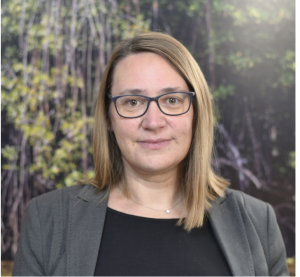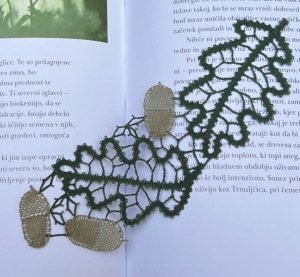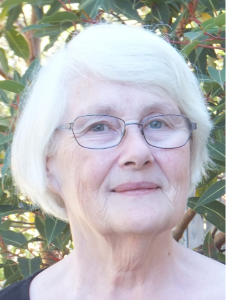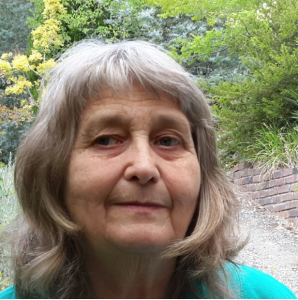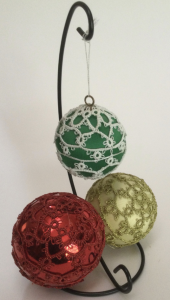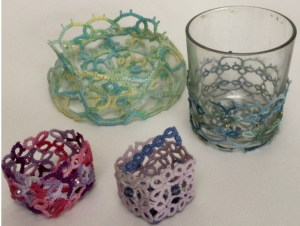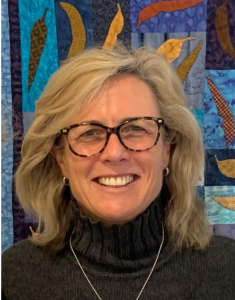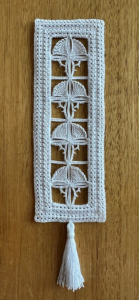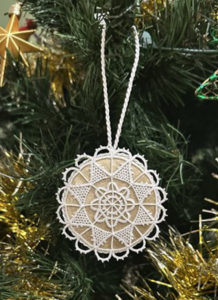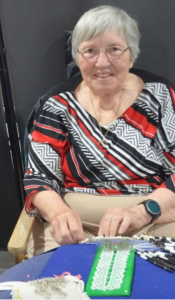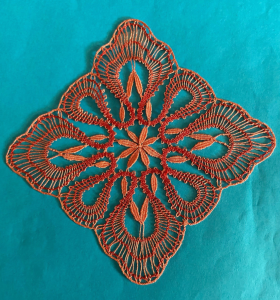Simona Strgulc Krajšek
Bobbin Lace Society of Ljubljana
Simona is from Ljubljana, Slovenia. She is a teaching assistant and lecturer in botany at the University of Ljubljana. She has been making bobbin lace for about 25 years. In Ljubljana, she is a mentor of two groups, and from time to time, she also leads bobbin lace workshops in Slovenia and abroad. She is a founding member of the Bobbin Lace Society of Ljubljana and a member of the International Organization for Bobbin and Needle Lace OIDFA. She participated in the preparation of several lace exhibitions, with which Slovenia presented itself at world lace congresses. She loves to research old patterns and lace but also draws new patterns for teaching or lace exhibitions. In 2024, she published a book of lace patterns, Lace Bookmarks co- authored with Ann Keller from Ireland.
Oak leaves and acorns
Bookmark in Slovenian bobbin lace techniques
Oak leaves are made in narrow tape, with 5 pairs of bobbins. The leaf veins are false plaits which are typical for Slovenian blind tape technique. Making the acorns is the demanding part of this lace. We will learn how to start the half-stitch with a straight edge and how to add pairs in the half-stitch. We will pay special attention to creating a relief transition between the acorn cup and the nut. We will also learn how to remove the pairs from the cloth stitch and how to finish the lace with a straight edge. All these techniques are frequently used in the lace designs originating from Slovenia.
THE LENGTH OF THE WORKSHOP: 20 hours
BOBBINS AND THE THREAD: 5 pairs of cotton No. 40 for narrow tape, 9–11 pairs for acorns
TECHNIQUES: narrow tape, cloth stitch with inside pins (straight edge), half stitch, plaits, false plaits. The workshop is suitable for intermediate and experienced lacemakers. Thread, pattern and instructions for the workshop will be provided. Please bring the pillow, bobbins, pins, scissors and crochet hook (0.5 mm).
Christine Johnson
I started making bobbin in 1981 and I have a working knowledge of most styles of bobbin lace, having done workshops overseas or with international tutors visiting Australia, but I have 3 particular areas of interest. One is the study of the Danish point ground lace of the early 19th century (generally known as “old” Tønder lace) and the reconstruction of some of the more beautiful floral designs of 1800-1850. Binche revival lace, a late 19th century/early 20th century Belgian lace, is another interest and I have completed the 4-year summer school course taught by Anne-Marie Verbeke-Billiet at the Kantcentrum in Bruges. For relaxation, I tend to revert to Torchon lace and the “Too Many Torchon Mats” project is ongoing.
I first started teaching bobbin lace in Sydney in 1988, inheriting Elwyn Kenn’s class, and I also conducted workshops on the mounting of lace. Then after a 15-year gap, during which time my work took me to Newcastle and Perth, I returned to Sydney and resumed teaching in 2005. Although my initial passion was for ensuring that beginners got a sound grounding in the techniques of bobbin lace, I am now more interested in encouraging lacemakers to explore beyond the basics and have spent much of the past decade developing a set of workshops “Adventures in Torchon”. I have been the convenor of the Epping Lace Group since 2019 and the librarian for the NSW Branch of the ALG since 2020.
Adventures in Torchon Lace: “FULLWORK”
The workshop I am offering for this AGM looks at the solid shapes of Torchon lace, conventionally blocks/diamonds, lozenges, chevrons and trails worked in cloth stitch or half stitch. We explore a range of further shapes and will also look at using decorations and different stitches to liven up what could otherwise be regarded as solid blobs. A number of quite technical aspects will be covered, including directional changes in trails, trail crossing methods, options for horizontal starts and finishes, choices for working vertical edges and some of the opportunities and limitations that may be encountered when combining some of these pattern elements. The workshop is aimed at extending the skills of lacemakers who already have a sound grounding in Torchon lace, but some simpler exercises will be available for less experienced lacemakers. Between 12 and 20 patterns, mostly bookmarks, will be provided, so students can choose the techniques on which they would most like to concentrate. Fiddling with the patterns to personalise the final lace is highly encouraged, although just picking a pattern that takes your fancy and following my interpretation of it is quite acceptable if that is what you want to do. Use of colour is at your discretion.
Lacemakers who have done previous workshops with me are welcome to continue to explore the themes/patterns of those workshops if they prefer and any of my patterns that have been published in “Australian Lace” may also be chosen as an alternative.
Christine Beswick – 3D Tatting
I have a teaching certificate from the Australian Lace Guild and have been a member for over 40 years. I enjoy all forms of lace and have completed a stage 1 or 2 certificate in all of the offered laces and hold a stage 4 teaching certificate.
I am keen to pass on my lacemaking skills to keep these old crafts alive into the future, teaching several different laces both locally and interstate as well as private lessons and teaching three different techniques on a craft cruise.
I have served on our state committee many times and was the proficiency coordinator for 6 years while serving on the national committee
A large part of my life has been and still is travelling the world attending congresses and courses to increase my knowledge and have attended all of the Australian Lace Guild AGM’s since 1984 taking many of the workshops.
I spent over 5 years identifying and cataloguing the lace collection of the Art Gallery of South Australia enabling an exhibition to be held during the International Lace Congress held in Adelaide in 2014. I am also a curator of our local South Australian Branch collection. I was a judge for the Royal Canberra Show for many years and still judge at the Royal Adelaide Show plus some country shows.
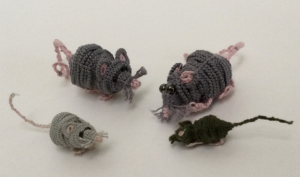
3D tatted mice
Di Kirchner
My love of embroidery grew when I was working for over 20 years with Country Bumpkin, where I had the opportunity to explore, design and teach needlework. To further my knowledge and skills completed a Diploma in Technical Hand Embroidery at the Royal School of Needlework this year. I have a particular interest in traditional embroidery and the stitches used. My current interest is Needlelace from the European Continent, in particular Historical Italian Needlelace. My main aim is to continue to encourage more people to try embroidery, through my teaching and sharing of the wonderful benefits it can offer.
I have been in Inspirations Studios’ magazines and books, teaching at Create in Stitch in Adelaide and for the Embroiderers Guild of South Australia, and started teaching around Australia in 2022. I will be teaching internationally for the first time in March 2025 at The Embroiderers Great Escape in New Zealand.
Class 1 Reticella Pansies Bookmark
Intermediate Level Class – Some experience in Needlelace is required.
This bookmark design is embroidered in the Italian style of cutwork embroidery on counted fabric called Reticella or historically Reticello. Once the cutwork areas are established, they are then filled with a beautiful needlelace pattern resembling a floral posy. A small tassel is added at the bottom.
Design size is 7cm x 19cm. Kit which includes notes, fabric, threads and needles costs $45.00
Class 2 Christmas Star Ornament
Beginner/Intermediate Level Class – Some experience in Needlelace is required.
The central Christmas Star design is embroidered
in the Italian style of needlelace called Aemilia Ars. It often referred to as ‘Punto in aria’, stiches in the air embroidery. The Aemilia Ars Star is embroidered on a card and then attached to a silk covered backing and a twisted cord is added.
Design size of the ornament is 7.5cm. Kit which includes notes, threads, needles and card costs $45.00
In 1985 I met Joyce Campbell who was demonstrating lace making and I joined her classes the next week.
Joyce taught me to make many different types of bobbin lace and in 1987 she encouraged me to start teaching under her supervision, “The Hackham Lace Group” and later the ‘Almond Blossom Lace Makers were created.
I make mostly Torchon Lace and have designed and published two small pattern books as well as other Torchon lace patterns.
I learned the techniques of Schneeberger lace from a German friend, who came from the Schneeberg area of Germany.
Shneeberger lace is a relatively new continuous braid lace which uses special techniques such as an edge plait, single thread picots and braids widening and narrowing without added pairs or half-stitches. As there are many sewings I work with German bobbins or those without spangles.

